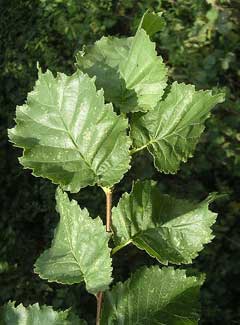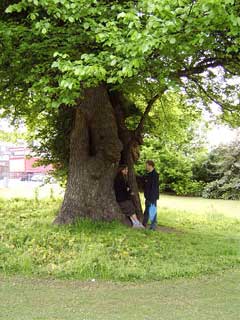 |
|
|
 |
| The larger of the two "Preston Twins", a pair of English Elms in Preston Park, Brighton, England. Thought to be the largest surviving English Elms in Europe |
Translate this page:
Summary
Physical Characteristics

 Ulmus procera is a deciduous Tree growing to 35 m (114ft) by 15 m (49ft) at a fast rate.
Ulmus procera is a deciduous Tree growing to 35 m (114ft) by 15 m (49ft) at a fast rate.
See above for USDA hardiness. It is hardy to UK zone 6 and is not frost tender. It is in flower from February to March, and the seeds ripen from May to June. The species is hermaphrodite (has both male and female organs) and is pollinated by Wind.
It is noted for attracting wildlife.
Suitable for: light (sandy), medium (loamy) and heavy (clay) soils and prefers well-drained soil. Suitable pH: mildly acid, neutral and basic (mildly alkaline) soils. It can grow in semi-shade (light woodland) or no shade. It prefers moist soil. The plant can tolerate maritime exposure.
It can tolerate atmospheric pollution.
UK Hardiness Map
US Hardiness Map
Synonyms
U. campestre. pro parte. U. glabra pubescens. U. surculosa.
Plant Habitats
Woodland Garden Canopy;
Edible Uses
Edible Parts: Fruit Inner bark Leaves
Edible Uses: Tea
Leaves - raw or cooked[2, 179, K]. They can be a little bit bitter, especially if not very young, and have a mucilaginous texture[K]. They make a nice addition to a mixed salad[K]. Immature fruits, used just after they are formed - raw[2, 177]. An aromatic, unusual flavour, leaving the mouth feeling fresh and the breath smelling pleasant[132]. They contain about 34.4% protein, 28.2% fat, 17% carbohydrate, 5% ash[179]. Inner bark - cooked. A mucilaginous texture[179]. It can be dried, ground into a powder and then used as a thickening in soups etc or mixed with cereals when making bread[2, 177]. A tea is made from the leaves[177].
References More on Edible Uses
Medicinal Uses
Plants For A Future can not take any responsibility for any adverse effects from the use of plants. Always seek advice from a professional before using a plant medicinally.
Astringent Bach Demulcent Diuretic Eczema Homeopathy Mouthwash Resolvent
Skin Tonic Vulnerary
The dried inner bark is anti-inflammatory, astringent, demulcent, mildly diuretic, resolvent, tonic and vulnerary[4, 7, 9]. It is used both internally and externally in the treatment of diarrhoea, rheumatism, wounds, piles etc and is also used as a mouthwash in the treatment of ulcers[4, 9, 66]. The inner bark is harvested from branches 3 - 4 years old and is dried for later use[9]. The sap has been used in the treatment of baldness[7]. The leaves are astringent and have been powdered then used in the treatment of haemorrhoids[7]. A decoction is used to treat reddened and inflamed skin as well as to relieve various skin disorders[7]. The plant is used in Bach flower remedies - the keywords for prescribing it are 'Occasional feelings of inadequacy', 'Despondency' and 'Exhaustion from over-striving for perfection'[209]. A homeopathic remedy is made from the inner bark[4]. It is used as an astringent[4] and as a treatment for eczema[9].
References More on Medicinal Uses
The Bookshop: Edible Plant Books
Our Latest books on Perennial Plants For Food Forests and Permaculture Gardens in paperback or digital formats.

Edible Tropical Plants
Food Forest Plants for Hotter Conditions: 250+ Plants For Tropical Food Forests & Permaculture Gardens.
More

Edible Temperate Plants
Plants for Your Food Forest: 500 Plants for Temperate Food Forests & Permaculture Gardens.
More

More Books
PFAF have eight books available in paperback and digital formats. Browse the shop for more information.
Shop Now
Other Uses
Dye Tannin Wood
A fibre from the inner bark is very tough[4]. It is used for making mats and ropes[4]. Tannin and a dyestuff are obtained from the inner bark[7]. No details of the colour are given. Wood - close-grained, free from knots, very durable under water, fairly hard, elastic, withstands abrasion and salt water, but does not take a high polish. It is used for water pipes, wheels, mallet heads, ships keels etc[4, 7, 11] and is a good firewood[6].
Special Uses
Attracts Wildlife
References More on Other Uses
Cultivation details
Prefers a fertile soil in full sun[188], but is easily grown in any soil of at least moderate quality so long as it is well drained[1]. Tolerant of atmospheric pollution[4]. The English elm is susceptible to 'Dutch elm disease', a disease that has destroyed the greater part of all the elm trees growing in Britain. Mature trees killed back by the disease will often regrow from suckers, but these too will succumb when they get larger. There is no effective cure (1992) for the problem, but most E. Asian, though not Himalayan, species are resistant to the disease so the potential exists to develop new resistant hybrids with the native species[200]. The various species hybridize freely, the pollen stores well and can be kept for use with species that flower at different times[200]. A food plant for the caterpillars of many lepidoptera species[30], there are 80 species of insects associated with this tree[24]. A good tree for growing grapes into[18].
References Carbon Farming Information and Carbon Sequestration Information
Temperature Converter
Type a value in the Celsius field to convert the value to Fahrenheit:
Fahrenheit:
The PFAF Bookshop
Plants For A Future have a number of books available in paperback and digital form. Book titles include Edible Plants, Edible Perennials, Edible Trees,Edible Shrubs, Woodland Gardening, and Temperate Food Forest Plants. Our new book is Food Forest Plants For Hotter Conditions (Tropical and Sub-Tropical).
Shop Now
Plant Propagation
Seed - if sown in a cold frame or outdoor seedbed as soon as ripe it usually germinates in a few days. A high proportion of the seed is not viable but seed is normally freely produced and can be sown thickly to take into account the poor viability. Stored seed does not germinate so well and should be sown in early spring. When they are large enough to handle, prick the seedlings out into individual pots and grow them on in the greenhouse for their first winter. Plant them out into their permanent positions in late spring or early summer, after the last expected frosts. Plants should not be allowed to grow for more than two years in a nursery bed since they form a tap root and will then move badly. Layering of suckers or coppiced shoots.
Other Names
If available other names are mentioned here
Native Range
TEMPERATE ASIA: Iran, Lebanon, Syria, Turkey, Russian Federation-Ciscaucasia (Ciscaucasia), Armenia, Azerbaijan, Georgia, Russian Federation (Dagestan) EUROPE: Denmark, United Kingdom, Sweden (south), Austria, Belgium, Switzerland, Czech Republic, Germany, Hungary, Netherlands, Slovakia, Russian Federation-European part (European part (south)), Belarus, Lithuania, Ukraine (incl. Krym), Albania, Bulgaria, Bosnia and Herzegovina, Greece (incl. Crete), Croatia, Italy, North Macedonia, Montenegro, Romania, Serbia, Slovenia, Spain (incl. Baleares), France (incl. Corsica), Portugal AFRICA: Spain (Canarias), Algeria (north), Morocco, Tunisia
Weed Potential
Right plant wrong place. We are currently updating this section.
Please note that a plant may be invasive in one area but may not in your area so it's worth checking.
Conservation Status
IUCN Red List of Threatened Plants Status :

Growth: S = slow M = medium F = fast. Soil: L = light (sandy) M = medium H = heavy (clay). pH: A = acid N = neutral B = basic (alkaline). Shade: F = full shade S = semi-shade N = no shade. Moisture: D = dry M = Moist We = wet Wa = water.
Now available:
Food Forest Plants for Mediterranean Conditions
350+ Perennial Plants For Mediterranean and Drier Food Forests and Permaculture Gardens.
[Paperback and eBook]
This is the third in Plants For A Future's series of plant guides for food forests tailored to
specific climate zones. Following volumes on temperate and tropical ecosystems, this book focuses
on species suited to Mediterranean conditions—regions with hot, dry summers and cool, wet winters,
often facing the added challenge of climate change.
Read More
Expert comment
Author
Salisb.
Botanical References
1117200
Links / References
For a list of references used on this page please go here
Readers comment
© 2010, Plants For A Future. Plants For A Future is a charitable company limited by guarantee, registered in England and Wales. Charity No. 1057719, Company No. 3204567.